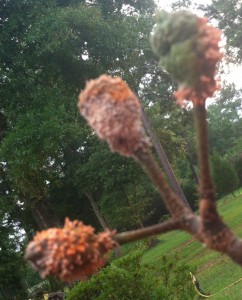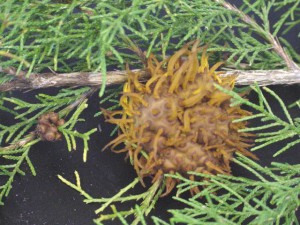
Cedar-Apple rust or Cedar-Quince rust (Gymnosporangium) symptoms on pear fruit. Image Credit Shep Eubanks, UF IFAS.
This is the season for fruit harvesting, particularly for those fruits in the rose family such as plum, quince, peach, pear and apple. Many avid home horticulturists have been enjoying the fruits of their labor, but some have been thwarted by an unlikely and ugly disease.
This fungal disorder, commonly called cedar-apple rust and caused by various species of Gymnosporangium, has the potential to ruin Quince, Pear and Apple crops in gardens throughout Northwest Florida. Early scouting and vigilance will pay off.
This condition begins on native juniper species (known as cedars). A spore producing gall forms on the branches of the cedar tree, which begin to produce spores during wet weather. Spores, once produced, can travel up to a mile via wind. If spores land on susceptible plant tissue when a film of water is present, it will germinate and infect the fruit, twig or leaf. Although black spots develop on the plant with in 7-10 days of infection, orange tubes called aecia won’t develop until 4 or more weeks after infection. Next, spores are released from the aecia located on the fruit tree and travel to infect new juniper plants . The infected junipers will not show symptoms until the next growing season but they can manifest as galls or orange ooze present under bark. Different species of Gymnosporangium will infect trees differently. Some live only for one year while others, known as ceder-quince rusts, can last up to 20 years. Twigs infected with this disease usually die within several years of infection.
Although this may seem like an impossible situation, several control strategies exist.
- Remove Infected branches: Removal of infected plant tissue will reduce the spread of the disease in your garden.
- Removal of infected juniper host species: If the juniper or “cedar” in your landscape is something you can sacrifice, removal is warranted in cases of heavy infection.
- Avoid planting susceptible species of juniper next to susceptible fruit tree species.
- Treatment of fruit trees with fungicide: Preventative fungicidal sprays of products containing the active ingredients of sulfur, captan, chlorothalonil, or mancozeb and similar products can be effective. They will not cure existing conditions but are useful if you know that rusts are present in your area. Please read all pesticide labels before application, since there are pre-harvest limitations present on some products.
For additional information, please consult you local county extension office or review these publications by UF IFAS specialists (Florida Plant Disease Management Guide) and the Missouri Botanical Garden.
- Woodland Pinkroot Adds Vibrant Color to Spring Landscapes - April 27, 2023
- Easy Care Roses for the Gulf South - April 20, 2023
- Herb Gardening: When Oregano is Flavorless - March 9, 2023

